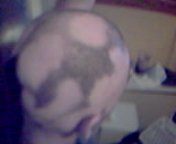Alopecia areata
Alopecia areata ("baldness in spots") is a form of hair loss from areas of the body, usually from the scalp. Because it causes bald spots on the head especially in the first stages, it is also called spot baldness. Hair loss can extend to eyebrows, eyelashes and facial and nasal hair and create more bald spots elsewhere in the body. more...
Types
- Alopecia areata monolocularis describes baldness in only one spot.
- Alopecia areata multilocularis refers to multiple areas of hair loss.
- If the patient loses all the hair on his/her scalp, the disease is then called Alopecia areata totalis.
- If all body hair, including pubic hair, is lost, the diagnosis then becomes Alopecia areata universalis.
- The disease may also be limited only to the beard (Alopecia areata barbae).
- A possible condition called Diffuse alopecia areata may cause a person with mixed grey and dark hairs to lose all their dark hairs at once due to a psychological trauma, causing the patient's hair to appear to have turned white overnight.
Causes
Alopecia areata is thought to be a minor autoimmune disease that makes the body to treat its hair follicles as foreign tissue and suppress or stop hair growth. It is not contagious but may be hereditary - there are a few recorded cases of babies being born with congenital alopecia areata. Stress has not been proven to be a crucial factor.
Diagnosis
First symptoms are small, soft, bald patches which can take just about any shape but are most usually round. Initial presentation most commonly occurs in the late teenage years but can happen with people of all ages. It most often affects the scalp but may occur on any hair-bearing part of the body. There may be different skin areas with hair loss and regrowth in the same body at the same time. It may go into remission for a time or permanently. The longer the hair loss persists, the smaller the chance that it will grow back. Fingernails may be affected, especially in severe cases where various nail changes may appear, the most common of which would be pitting of the fingernails.
In the diagnosis of alopecia areata, exclusion of other treatable diseases that cause hair loss such as trichotillomania and tinea capitis is important. In trichotillomania, there may be patches of broken hair and there will not be the skin changes associated with alopecia areata.
Treatment
If the affected region is small, it is reasonable to observe the progression of the illness as the problem often spontaneously regresses and the hair grows back. In cases where there is severe hair loss, there has been limited success treating alopecia areata with steroids (intradermal, topical or oral), other immune modulators, minoxidil or phototherapy.
Prognosis
Effects of alopecia areata are mainly psychological (loss of self image due to hair loss). However, patients also tend to have a slightly higher incidence of asthma, allergies and atopic dermal ailments and even hypothyroidism. Loss of hair also means that the scalp burns more easily in the sun. Loss of nasal hair increases severity of hay fever and similar allergic conditions. They may also have aberrant nail formation because keratin forms both hair and nails.
Read more at Wikipedia.org



